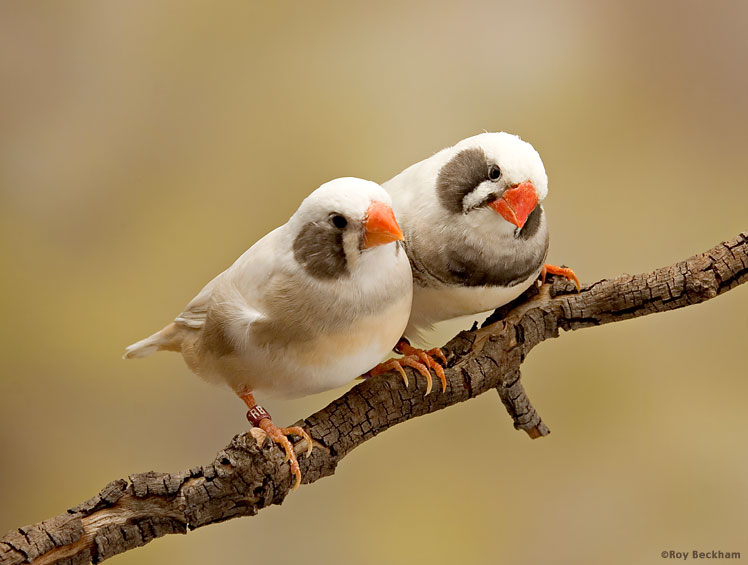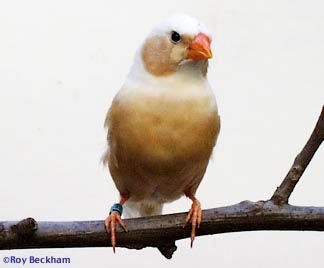




 |
|
|||||||||||||||||||||
 |
|
|
|
|
|
|
|
|
|
|||||||||||||
|
|
|
|
|
|
||||||||||||||||||
|
|
|
|
|
|
|
|
|
|
||||||||||||||
|
|
|
|
|
|
||||||||||||||||||
|
|
|
|
|
|
|
|
|
|
||||||||||||||
|
|
|
|
|
|
||||||||||||||||||
|
|
|
|
|
|
|
 |
|
|||||||||||||||
 |
 |
|
||||||||||||||||||||
|
|
|
|
||||||||||||||||||||
|
|
|
|
|
|
|
|
|
|
|
|
|
|
|
|
|
|
|
|
|
|
|
|
| Gray Cheek/Fawn Cheek Zebra Finch | ||||||
 |
||||||
| A combination of Gray Cheek and Black Cheek mutations. Female (left) and Fawn Cheek male (right) | ||||||
|
Mutation Effects Male: The Fawn Cheek (FC) mutation reduces the gray areas of the Zebra finch to a white or near white color. The cheek patches are also changed in that they show the base body color. That is to say that Gray series birds will have a gray cheek patch (often called a Gray Cheek or GC) and fawn series birds will have a fawn cheek patch. The flanks remain unchanged, but the breast bar and tear marks can often be reduced in intensity giving them a softer appearance. There is often some fawn lacing in the wings and the belly will retain any buff coloring. The tail bars are also distorted. Female: The base color will be reduced to white or near white as in the male. With this mutation, like the Black Cheek mutation, the hens have cheek patches like the males. They can still be distinguished by the lack of flank markings, breast bars and the lighter colored beak. The buff coloring on the belly is usually more evident on the females than the males. Fledglings: Young Fawn Cheeks are easily identified in the nest. If not mixed with other white feathered birds in the nest (CFWs, Pieds, Whites, Florida Fancy or Dominant Silvers), they can be identified as soon as the wing feathers start show. Otherwise, when FCs fledge they will have cheek patches. they also have a horn-colored beak. Combinations Many who breed Gray Cheek birds often look to Black Cheek Zebras to darken or strengthen the color in the cheeks. There is some improvement in the birds that I have seen pictures of, but it has been reported that a genetic phenomenon known as crossing over is required to combine the two mutations. Crossing over is a random occurrence so one cannot predict how long, if ever, before the combination will occur. (Update: I now have a few specimens from imported birds) The Fawn cheek mutation can also be combined with the Black Breasted mutation, but the expected result of enlarged cheek patches do not develop. The breast bar and other features of the Black Breasted mutation show, but not the extended cheek patches. I personally don't think that the Fawn Cheek mutation works very well with any of the mutations that cause a dilution of the base color or markings, which is most of the Zebra finch mutations and includes CFW, Lightback, Pied, Florida Fancy, Penguin, Dominant or Recessive Silver, and of course White. Fawn Cheek Black Face Combination (click to view)
Notes The dilution amount of the base color is variable. I prefer the white color often seen (see above and below), but others prefer the more buff colored birds (click to view one from a show). This buff coloring is often seen when combined with the Black Face mutation. Many who first see the Fawn Cheek mutation confuse it with the CFW mutation. They are distinctly different mutations despite their similarities and can usually be distinguished by the buff coloring on the belly of the FC birds. Also, it is fairly unusual to see a CFW with orange markings at the strength of the FC. Fawn Cheeks are also sometimes confused with Florida Fancies, but can be distinguished from them by their black markings (breast and tear in males and tear marks in females) The FC/GC mutation will often have what appears to be pied-like markings in them. These white blotches are the result of the mutation itself and not because of a combination with the Pied gene. They can usually be distinguished from true pied by the softness of the white edge. That is, the edge of the "pied" area will have a soft appearance. True pied usually has a sharp, defined edge to its white areas. |


Fawn Cheek male (left) Fawn Cheek female (right)
